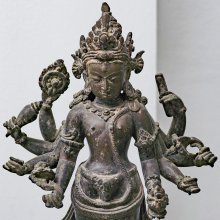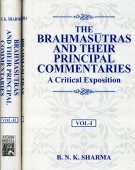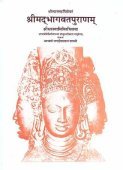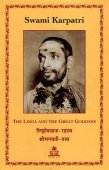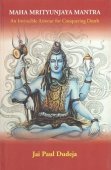Prakriti, Prakṛti: 42 definitions
Introduction:
Prakriti means something in Buddhism, Pali, Hinduism, Sanskrit, Jainism, Prakrit, the history of ancient India, Marathi, Hindi. If you want to know the exact meaning, history, etymology or English translation of this term then check out the descriptions on this page. Add your comment or reference to a book if you want to contribute to this summary article.
The Sanskrit term Prakṛti can be transliterated into English as Prakrti or Prakriti, using the IAST transliteration scheme (?).
Alternative spellings of this word include Prakrati.
Images (photo gallery)
In Hinduism
Purana and Itihasa (epic history)
Source: Google Books: Encyclopaedic Dictionary of PurāṇasPrakṛti (प्रकृति, matter) and Puruṣa (spirit) are two basic factors essential for production of the Prapañca (the visible world which is the scene of manifold action) as man and woman are for the production of progeny. From Puruṣa (male), Prakṛti (female) originated and then they together created the Prapañca.
Before creation Prakṛti lay merged with the Supreme Spirit without separate existence. But when the desire for creation was aroused, this Supreme Spirit divided itself into Prakṛti and Puruṣa. Then the right half becomes 'Puruṣa' and the left half 'Prakṛti'. Even though they are thus two yogīndras ('kings among sages') they see themselves as merged with the eternal One like fire and heat and assert the truth (Sarvaṃ Spirit). It was this basic Prakṛti that took forms as the five goddesses, Durgā, Lakṣmī, Saravatī, Sāvitrī and Rādhā. (9th Skandha, Devī Bhāgavata)
Source: archive.org: Shiva Purana - English Translation1) Prakṛti (प्रकृति) refers to “cosmic nature” while Puruṣa refers to the “cosmic man or being”, as defined in the Śivapurāṇa 1.16. Accordingly, “[...] O foremost among sages, ordinary parents bestow hidden treasures to the son who renders special service. Hence a devotee shall worship the phallic emblem in the manner of mother and father (pitṛ-mātṛ) for the acquisition of the hidden great bliss. Bharga is Puruṣa (Cosmic man or Being) and Bhargā is Prakṛti (Cosmic Nature). Puruṣa is of hidden latent conception and Prakṛti is of manifest inner conception. Since it is the father who conceives first, the Puruṣa has the primordial conception. The unification of Puruṣa and Prakṛti is the first birth. Its manifestation in the Prakṛti is called the second birth. The creature, dead even as it is born, takes up its birth from the Puruṣa”.
2) Prakṛti (प्रकृति) is another name for Śakti (prime cause, created from the body of Īśvara), according to Śivapurāṇa 2.1.6, while explaining the time of great dissolution (mahāpralaya):—“[...] this Śakti is called by various names. Pradhāna, Prakṛti, Māyā, Guṇavatī, Parā. The mother of Buddhi Tattva (The cosmic Intelligence), Vikṛtivarjitā (without modification). That Śakti is Ambikā, Prakṛti and the goddess of all. She is the prime cause and the mother of the three deities. [...]”.
Source: Cologne Digital Sanskrit Dictionaries: The Purana Index1a) Prakṛti (प्रकृति).—Matter as opposed to Puruṣa; could be conquered by one's yogabala;1 has the three guṇas—satva, rajas and tamas.2 Eight kinds of;3 the seven principles leading to pralaya;4 also known as pradhāna and avyakta; makes and unmakes the universe; created by the unborn Iśvara;5 is yoganidrā.6
- 1) Bhāgavata-purāṇa I. 8. 18; III. 5. 46; Brahmāṇḍa-purāṇa II. 19. 173, 195-7; III. 42. 47; 43. 3.
- 2) Bhāgavata-purāṇa VII. 1. 7.
- 3) Ib. VII. 7. 22; XI. 22. 18-24.
- 4) Ib. XII. 4. 5; Brahmāṇḍa-purāṇa IV. 2. 231; 6. 6; 15. 7; 43. 76.
- 5) Matsya-purāṇa 3. 14; 154. 356; Viṣṇu-purāṇa I. 2. 19.
- 6) Ib. V. 2. 7; VI. 4. 34-5.
1b) The subjects of a king; Pṛthu treated them with respect;1 acquiesed in selecting Pūru and also Dyumatsena.2
- 1) Bhāgavata-purāṇa IV. 17. 2; Brahmāṇḍa-purāṇa III. 49. 17; Matsya-purāṇa 34. 26; 226. 6; 240. 11.
- 2) Ib. 36. 5; 214. 16.
1c) Seven kinds, which support the monarch.*
- * Bhāgavata-purāṇa VI. 14. 17-18.
1d) Usually eight, the eight places of gods, from Brahmā to Piśāca, eight-fold aiśvarya, the eight rūpas, etc.1 regarded as truth and their opposite as false.2
1e) Seven avyakta, waters, tejas, vāyu, ākāśa, bhūtādi and mahat enter gradually and bring about Pratyāhara;1 also eight kinds.2

The Purana (पुराण, purāṇas) refers to Sanskrit literature preserving ancient India’s vast cultural history, including historical legends, religious ceremonies, various arts and sciences. The eighteen mahapuranas total over 400,000 shlokas (metrical couplets) and date to at least several centuries BCE.
Shaivism (Shaiva philosophy)
Source: bhagavadgitausa.com: Kashmir SaivismPrakrti = Primeval matter, nature. Mula Prakrti = root matter, primal matter; Mula karana = root cause. Prakrti is the undifferentiated matter; it is inert because the latent qualities Sattva, Rajas and Tamas (Virtue, passion, and darkness) are inert or in abeyance. When Prakrti undergoes transformation, the process is Vikrta and the product is Vikrti, which has three qualities: Sattva, Rajas and Tamas. In Sankhya system, all Purusas have one Prakrti; in Trika system, each Purusa has its own Prakrti.

Shaiva (शैव, śaiva) or Shaivism (śaivism) represents a tradition of Hinduism worshiping Shiva as the supreme being. Closely related to Shaktism, Shaiva literature includes a range of scriptures, including Tantras, while the root of this tradition may be traced back to the ancient Vedas.
Ayurveda (science of life)
Source: Google Books: Essentials of AyurvedaPrakṛti (प्रकृति, “constitution”).—The constitution of a person is decided by the doṣa predominant at the combination of sperm and ovum (fertilization) which becomes almos fixed for the whole life.
- Vātika (vāta-prakṛti),
- Pittaka (pitta-prakṛti),
- Kaphaja (kapha-prakṛti).
Constitution is also decided on the basis of psychic qualities—sattva, rajas and tamas:
- Sāttvika (sattva-prakṛti),
- Rājasa (rajas-prakṛti),
- Tāmasa (tamas-prakṛti).
Similarly there are also bhūtaprakṛtis (constitution according to predominance of bhūtas) which can be known from their respective features. To know a person, one should examine his constitution properly. The man should fix his routine according to his constitution in mind. Similarly, the physician should keep the constitution in mind while prescribing medicines (and diet) for a patient.
Source: archive.org: Sushruta samhita, Volume IIThe latent/unmanifest supreme nature (Prakriti) is the progenitor of all created things. She is self- begotten and connotes the three fundamental or primary virtues of Sattva, Rajas and Tamas. She is imaged or embodied in the eightfold categories of Avyakta (unmanifest), Mahān (intellection), Ahamkāra (Egoism) and the Five Tanmātras or elementals (proper sensibles of hearing, touch, sight, taste, and smell) and is the sole and primary factor in working out the evolution of the universe.
Source: gurumukhi.ru: Ayurveda glossary of terms1) Prakṛti (प्रकृति):—1. The nature of an individual or a substance. 2. The physical and psychological features specific to an individual that are produced to the dominant Doṣa prevailing at the time of conception. Prakrti may be classified as Deha Prakrti (physical) and Manasa Prakrti (psychological). Deha Prakrti may be produced due to the dominance of a single Dosa, two Dosas or due to a combination of all the three Dosas.
2) [prakṛtiḥ] The primary and original cause of universe which is having three properties viz. sattva, raja, tama

Āyurveda (आयुर्वेद, ayurveda) is a branch of Indian science dealing with medicine, herbalism, taxology, anatomy, surgery, alchemy and related topics. Traditional practice of Āyurveda in ancient India dates back to at least the first millenium BC. Literature is commonly written in Sanskrit using various poetic metres.
Natyashastra (theatrics and dramaturgy)
Source: Wisdom Library: Nāṭya-śāstra1) Prakṛti (प्रकृति) refers to a class of rhythm-type (chandas) containing twenty-one syllables in a pāda (‘foot’ or ‘quarter-verse’), according to the Nāṭyaśāstra chapter 15. There are twenty-six classes of chandas and out of them arise the various syllabic meters (vṛtta), composed of four pādas, defining the pattern of alternating light and heavy syllables.
2) Prakṛti (प्रकृति) refers to the “characters” of songs (dhrūva) according to the Nāṭyaśāstra 32.400:—“the characters in a play (prakṛti) are of three kinds, viz. superior, inferior and middling”.
3) Prakṛti (प्रकृति) or Gati or Gata refers to a set of three rules used in the playing of drums (puṣkara) [with reference to Mṛdaṅga, Paṇava and Dardura] according to the Nāṭyaśāstra chapter 33.
The following are the three prakṛtis:
- Tattva,
- Ghana (=Anugata),
- Ogha.

Natyashastra (नाट्यशास्त्र, nāṭyaśāstra) refers to both the ancient Indian tradition (shastra) of performing arts, (natya—theatrics, drama, dance, music), as well as the name of a Sanskrit work dealing with these subjects. It also teaches the rules for composing Dramatic plays (nataka), construction and performance of Theater, and Poetic works (kavya).
Samkhya (school of philosophy)
Source: Wisdom Library: Sāṃkhya philosophyPrakṛti (प्रकृति, “material reality”) is a type tuṣṭi (complacence), classified internal (ādhyātmika) according to the Sāṃkhya theory of evolution. Tuṣṭi refers to a category of pratyayasarga (intellectual products), which represents the first of two types of sarga (products) that come into being during tattvapariṇāma (elemental manifestations), which in turn, evolve out of the two types of pariṇāma (change, modification).
Prakṛti (प्रकृति, “material”) is the first cause of the manifest material universe—of everything except the puruṣa. Prakṛti accounts for whatever is physical, both mind and matter-cum-energy or force. Since it is the first principle (tattva) of the universe, it is called the pradhāna, but, as it is the unconscious and unintelligent principle, it is also called the jaḍa.
It is composed of three essential characteristics (triguṇas). These are:
- sattva – poise, fineness, lightness, illumination, and joy; r
- rajas – dynamism, activity, excitation, and pain;
- tamas – inertia, coarseness, heaviness, obstruction, and sloth.
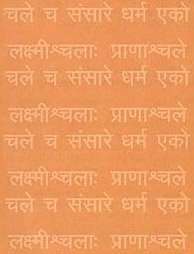
Samkhya (सांख्य, Sāṃkhya) is a dualistic school of Hindu philosophy (astika) and is closeley related to the Yoga school. Samkhya philosophy accepts three pramanas (‘proofs’) only as valid means of gaining knowledge. Another important concept is their theory of evolution, revolving around prakriti (matter) and purusha (consciousness).
Vyakarana (Sanskrit grammar)
Source: Shodhganga: Vaiyākaraṇabhūṣaṇasāra: a critical studyPrakṛti (प्रकृति).—Original base of a word which is used in language by the addition of affixes. It has two kinds: 1. Roots 2. Nominal stems.
Source: Wikisource: A dictionary of Sanskrit grammar1) Prakṛti (प्रकृति).—Material cause: cf.. तदर्थे विकृतेः प्रकृतौ । प्रकृतिरुपादानकारणं तस्यैव उत्तरमवस्थान्तरं विकृतिः (tadarthe vikṛteḥ prakṛtau | prakṛtirupādānakāraṇaṃ tasyaiva uttaramavasthāntaraṃ vikṛtiḥ) Kas.on P.V.1.12;
2) Prakṛti.—Original, as opposed to modified' (विकृति (vikṛti)); the original base of a word which is used in language by the addition of affixes. There are mentioned three kinds of such original words in grammar, roots (धातु (dhātu)), noun bases (प्रातिपदिक (prātipadika)) and affixes (प्रत्यय (pratyaya)). प्रकृति (prakṛti) is defined as शास्त्रप्रक्रियक्रियाव्यवहारे प्रकृतिप्रत्ययविभागकल्पनय शब्दार्थभावनायां प्रत्ययात् प्रथममुपादानकारणामिव या उपादीयते तां प्रकृतिरिति व्यापदिशन्ति (śāstraprakriyakriyāvyavahāre prakṛtipratyayavibhāgakalpanaya śabdārthabhāvanāyāṃ pratyayāt prathamamupādānakāraṇāmiva yā upādīyate tāṃ prakṛtiriti vyāpadiśanti)' in the Sringaraprakasa; cf. अपशब्दो ह्यस्य प्रकृतिः । न चापशब्दः प्रकृतिः (apaśabdo hyasya prakṛtiḥ | na cāpaśabdaḥ prakṛtiḥ) , न ह्यपशब्दा उपदिश्यन्ते न चानुपदिष्टा प्रकृतिरस्ति । (na hyapaśabdā upadiśyante na cānupadiṣṭā prakṛtirasti |) M.Bh. on Siva Sutra 2; cf. also कृत्प्रकृतिर्धातुः (kṛtprakṛtirdhātuḥ) M.Bh. on P. VI. 2. 139 Vart. 2; पदप्रकृतिः संहिता । पदप्रक्तीनि सर्व-चरणानां पार्षदानि (padaprakṛtiḥ saṃhitā | padapraktīni sarva-caraṇānāṃ pārṣadāni) Nir. I.17.

Vyakarana (व्याकरण, vyākaraṇa) refers to Sanskrit grammar and represents one of the six additional sciences (vedanga) to be studied along with the Vedas. Vyakarana concerns itself with the rules of Sanskrit grammar and linguistic analysis in order to establish the correct context of words and sentences.
Chandas (prosody, study of Sanskrit metres)
Source: Shodhganga: a concise history of Sanskrit Chanda literaturePrakṛti (प्रकृति) is one of the twenty-six varieties of Sanskrit metres (chandas) mentioned in the Chandaśśāstra 1.15-19. There are 26 Vedic metres starting with 1 to 26 letters in each pāda. It is a common belief that the classical metres are developed from these 26 metres. Generally a metre has a specific name according to it’s number of syllables (akṣara). But sometimes the same stanza is called by the name of another metre from the point of view of the pādas.
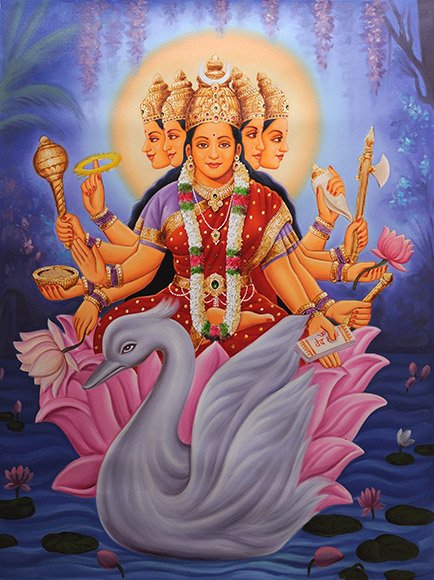
Chandas (छन्दस्) refers to Sanskrit prosody and represents one of the six Vedangas (auxiliary disciplines belonging to the study of the Vedas). The science of prosody (chandas-shastra) focusses on the study of the poetic meters such as the commonly known twenty-six metres mentioned by Pingalas.
Nirukta (Sanskrit etymology)
Source: Google Books: Encyclopaedic Dictionary of Purāṇas (nirukta)Prakṛti (प्रकृति, “matter”).—(a) “Pra” means “principal” and “Kṛti” means “creation”. Therefore, the word is meant ot convey the meaning “one that is principal factor for creation”. (b) “Pra” means “sāttvic”, “Kṛ” means “rājasic” and “ta” means “tāmasic” and the word “Prakṛti” thus conveys the power of the three guṇas. (c) “Pra” means “before” and “Kṛti” means creation and so Prakṛti means that which existed before creation.
Nirukta (निरुक्त) or “etymology” refers to the linguistic analysis of the Sanskrit language. This branch studies the interpretation of common and ancient words and explains them in their proper context. Nirukta is one of the six additional sciences (vedanga) to be studied along with the Vedas.
Vaishnavism (Vaishava dharma)
Source: Pure Bhakti: Bhagavad-gita (4th edition)Prakṛti (प्रकृति) refers to “material nature”. (cf. Glossary page from Śrīmad-Bhagavad-Gītā).
Source: Pure Bhakti: Brhad BhagavatamrtamPrakṛti (प्रकृति) refers to:—Predominated potencies; predominated principle; external energy; material nature. (cf. Glossary page from Śrī Bṛhad-bhāgavatāmṛta).

Vaishnava (वैष्णव, vaiṣṇava) or vaishnavism (vaiṣṇavism) represents a tradition of Hinduism worshipping Vishnu as the supreme Lord. Similar to the Shaktism and Shaivism traditions, Vaishnavism also developed as an individual movement, famous for its exposition of the dashavatara (‘ten avatars of Vishnu’).
Kavya (poetry)
Source: Brill: Śaivism and the Tantric Traditions (kavya)Prakṛti (प्रकृति) refers to the “natural state (of embodied creatures)”, according to Kālidāsa’s Raghuvaṃśa verse 8.88-90.—Accordingly: “The wise say that death is the natural state (prakṛti) of embodied creatures and life is a change in that state. If a being remains breathing even for a moment it is surely fortunate. The foolish man regards the loss of his dear one as a dart shot into his heart. Another man looks on the same as a dart that has been pulled out, for it is a door to beatitude. When we are taught that our own body and soul unite and then separate, tell me which wise person should be tormented by separation from the external objects of the senses?”.

Kavya (काव्य, kavya) refers to Sanskrit poetry, a popular ancient Indian tradition of literature. There have been many Sanskrit poets over the ages, hailing from ancient India and beyond. This topic includes mahakavya, or ‘epic poetry’ and natya, or ‘dramatic poetry’.
Ganitashastra (Mathematics and Algebra)
Source: archive.org: Hindu Mathematics1) Prakṛti (प्रकृति) represents the number 21 (twenty-one) in the “word-numeral system” (bhūtasaṃkhyā), which was used in Sanskrit texts dealing with astronomy, mathematics, metrics, as well as in the dates of inscriptions and manuscripts in ancient Indian literature.—A system of expressing numbers by means of words arranged as in the place-value notation was developed and perfected in India in the early centuries of the Christian era. In this system the numerals [e.g., 21—prakṛti] are expressed by names of things, beings or concepts, which, naturally or in accordance with the teaching of the Śāstras, connote numbers.
2) Prakṛti (प्रकृति) or “multiplier” refers to the “coefficient”, according to the principles of Bījagaṇita (“algebra” or ‘science of calculation’), according to Gaṇita-śāstra, ancient Indian mathematics and astronomy.—In Hindu algebra there is no systemmatic use of any special term for the coefficient. Ordinarily, the power of the unknown is mentioned when the reference is to the coefficient of that power. [...] However, occasional use of a technical term is also met with. Brahmagupta once calls the coefficient saṃkhyā (number) and on several other occasions guṇaka, or guṇakāra (multiplier). Pṛthūdakasvāmī (860) in his commentary on Brahmagupta’s Brāhmasphuṭasiddhānta calls it aṅka (number) or prakṛti (multiplier). These terms reappear in the works of Siddhāntaśekhara by Śrīpati (1039) and the Bījagaṇita by Bhāskara II (1150). The former also used rūpa for the same purpose
3) prakṛti (प्रकृति) or “origin” refers to the “coefficient (of the square of the unknown)” in Vargaprakṛti (“square-nature”), according to the principles of Bījagaṇita.—The indeterminate quadratic equation [Nx2 ± c = y2], is called by the Hindus vargaprakṛti or kṛtiprakṛti, meaning the “square-nature”. [...] According to Kṛṣṇa (1580) in his commentary on the Bījagaṇita of Bhāskara II: “That in which the varga (square) is the prakṛti (nature) is called the vargaprakṛti; for the square of yāvat, etc., is the prakṛti (origin) of this (branch of) mathematics. because this (branch of) mathematics has originated from the number which is the prakṛti of the square of yāvat, etc., so it is called the vargaprakṛti. In this case the number which is the multiplier of the square yāvat, etc., is denoted by the term prakṛti. (In other words) it is the coefficient of the square of the unknown”.
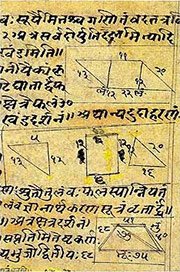
Ganitashastra (शिल्पशास्त्र, gaṇitaśāstra) refers to the ancient Indian science of mathematics, algebra, number theory, arithmetic, etc. Closely allied with astronomy, both were commonly taught and studied in universities, even since the 1st millennium BCE. Ganita-shastra also includes ritualistic math-books such as the Shulba-sutras.
Jyotisha (astronomy and astrology)
Source: Wisdom Library: Brihat Samhita by VarahamihiraPrakṛti (प्रकृति) refers to the “natural (condition)” (of planets), according to the Bṛhatsaṃhitā (chapter 16) (“On the planets—graha-bhaktiyoga”), an encyclopedic Sanskrit work written by Varāhamihira mainly focusing on the science of ancient Indian astronomy astronomy (Jyotiṣa).—Accordingly, “If at the time of reappearance, a planet should appear bright, of large disc and in his natural condition (prakṛti-sthita), not crossed by thunderbolts, meteoric falls or dust-storms and not suffer in conjunction with other planets or if he should be in his house or in his Uccakṣetra or if he should be within sight of a benefic planet, he will bring prosperity to the persons and objects presided over by him. [...]”.

Jyotisha (ज्योतिष, jyotiṣa or jyotish) refers to ‘astronomy’ or “Vedic astrology” and represents the fifth of the six Vedangas (additional sciences to be studied along with the Vedas). Jyotisha concerns itself with the study and prediction of the movements of celestial bodies, in order to calculate the auspicious time for rituals and ceremonies.
General definition (in Hinduism)
Source: WikiPedia: HinduismPrakṛti (प्रकृति, “nature”) is the basic nature of intelligence by which the Universe exists and functions It is described in Bhagavad Gita as the "primal motive force". It is the essential constituent of the universe and is at the basis of all the activity of the creation.
It is composed of the three gunas which are tendencies or modes of operation, known as
- sattva (creation),
- rajas (preservation),
- and tamas, (destruction)
Prakruti also means nature. Nature can be described as environment. It can also be used to denote the 'feminine' in sense of the 'male' being the purusha. Prakriti also means health in Marathi.
Source: Madangopal: Śrī Yugala-sahasra-nāma-stotraIn the 9th century Hayaśīrṣa-pañcarātra, Lakṣmī is called Prakṛti (Bhagavat-sandarbha 104). Prakṛti can mean cit-śakti (Laghu-bhāgavatāmṛta 1.2.59). Prakṛti can also mean kāraṇa (“cause”).
Source: Academia.edu: The concept of Prāyaścitta in the Introductory Passages of the RatnakaraṇḍikāPrakṛti (प्रकृति):—According to Yoga and Saṃkhya doctrine, each physical phenomenon is constituted of “a primal matter, called prakṛti or pradhāna. This primal matter contains three qualities or strands (guṇa): goodness (sattva), energy (rajas), and darkness (tamas)”. According to this worldview, “the three qualities are distributed in different proportions within the various constituents of the universe”.
In Buddhism
Mahayana (major branch of Buddhism)
Source: academia.edu: A Study and Translation of the GaganagañjaparipṛcchāPrakṛti (प्रकृति) refers to “living beings”, according to the Gaganagañjaparipṛcchā: the eighth chapter of the Mahāsaṃnipāta (a collection of Mahāyāna Buddhist Sūtras).—Accordingly, “Then on that occasion the Lord uttered these verses: [...] (107) Since all living beings are originally extinguished (prakṛti-nirvṛta), they are never born. His patience shining like this is not carelessness about this teaching. (108) Seeing all parts of personality as an illusion, knowing all spheres as the sphere of the dharma, considering the six sense organs as an empty town, this is to transcend the Māra inherent in the parts of personality. [...]”.

Mahayana (महायान, mahāyāna) is a major branch of Buddhism focusing on the path of a Bodhisattva (spiritual aspirants/ enlightened beings). Extant literature is vast and primarely composed in the Sanskrit language. There are many sūtras of which some of the earliest are the various Prajñāpāramitā sūtras.
Tibetan Buddhism (Vajrayana or tantric Buddhism)
Source: Brill: Śaivism and the Tantric Traditions (tantric Buddhism)Prakṛti (प्रकृति) refers to the “nature” (of consciousness), according to the Nāmamantrārthāvalokinī by Vilāsavajra, which is a commentary on the Nāmasaṃgīti.—Accordingly, [while describing Mahāvairocana]—“And then [the Sādhaka should visualise] Mahāvairocana on the principal seat, generated by means of the syllable āḥ. [Why has he four faces?] Since consciousness—which is of the nature (prakṛti) of the Dharma-Sphere since, by its nature, it lacks such forms as the grasped [i.e., the subject-object duality]—is four-faced. [This is] because the four liberation faces [/doors]—emptiness and the rest—are the cause of the origination of all meditative concentrations, [and this in turn is] because their ground is the Dharma-Sphere. [...]”.

Tibetan Buddhism includes schools such as Nyingma, Kadampa, Kagyu and Gelug. Their primary canon of literature is divided in two broad categories: The Kangyur, which consists of Buddha’s words, and the Tengyur, which includes commentaries from various sources. Esotericism and tantra techniques (vajrayāna) are collected indepently.
General definition (in Buddhism)
Source: Wisdom Library: Dharma-samgrahaPrakṛti (प्रकृति) or prakṛtiśūnyatā refers to “natural emptiness” one of the “twenty emptinesses” (śūnyatā) as defined in the Dharma-saṃgraha (section 41). The Dharma-samgraha (Dharmasangraha) is an extensive glossary of Buddhist technical terms in Sanskrit (e.g., prakṛti). The work is attributed to Nagarjuna who lived around the 2nd century A.D.
In Jainism
General definition (in Jainism)
Source: Encyclopedia of Jainism: Tattvartha Sutra 8: Bondage of karmasPrakṛti (प्रकृति, “species”) or Prakṛtibandha refers to one of the four kinds of bondage (bandha) according to the 2nd-century Tattvārthasūtra chapter 8.—Accordingly, “What is meant by species of bondage (prakṛti-bandha)? The innate nature of the bondage is called species of bondage. Knowledge obscuring etc are the eight kinds of species of bondage”.
According to verse 8.4, how many types of species bondage (prakṛti-bandha) are there? It is of eight types namely:
- knowledge obscuring (jñānāvaraṇa),
- perception obscuring (darśanāvaraṇa),
- feeling producing (vedanīya),
- deluding (mohanīya),
- lifespan determining (āyu),
- physique-making (nāma),
- status-determining (gotra),
- obstructive (antarāya).
Which out of these eight types of [prakṛti-bandha] karmas cause bondage of new karmas? Deluding karma is the only cause of bondage of new karmas. How these eight types of karmas are grouped in two classes? These can be clubbed as obscuring (ghātiā) and non-obscuring (aghātiā) karmas.
What are the sub divisions of the eight types of karmas? The 148 sub divisions of the eight types of karmas are: five for knowledge obscuring, nine for perception obscuring, two for feeling producing, twenty eight for deluding, four lifespan determining, two for status determining, ninety three for physique-making and five for obstructing karmas.

Jainism is an Indian religion of Dharma whose doctrine revolves around harmlessness (ahimsa) towards every living being. The two major branches (Digambara and Svetambara) of Jainism stimulate self-control (or, shramana, ‘self-reliance’) and spiritual development through a path of peace for the soul to progess to the ultimate goal.
India history and geography
Source: Cologne Digital Sanskrit Dictionaries: Indian Epigraphical GlossaryPrakṛti.—(HD); cf. Mahābhārata, II. v. 23, speaking of the seven prakṛtis which Nīlakaṇṭha explains as referring to Durga-adhyakṣa (commandant of the citadel), Bal-ādhyakṣa (con- troller general of the army), Dharma-ādhyakṣa (chief of the departments of charity and justice), Camūpati (commander of the army in the field), chaplain, physician and astrologer. The Milindapañha (IV. i. 36) mentions six officers, e.g., the com- mander-in-chief, prime minister, chief judge, chief treasurer, bearer of the sun-shade and bearer of the sword of state (cf. Ep. Ind., Vol. XV, p. 77, note 6). Cf. Mātra. (EI 16), a temple official. (IE 7-1-2), ‘twentyone.’ (EI 9), the Kṣatriya community. Cf. sa-tantuvāya-gokuṭa-śauṇḍika-ādi-prakṛtika (IE 8-5); subjects of a king. (CII 1), usage. Note: prakṛti is defined in the “Indian epigraphical glossary” as it can be found on ancient inscriptions commonly written in Sanskrit, Prakrit or Dravidian languages.

The history of India traces the identification of countries, villages, towns and other regions of India, as well as mythology, zoology, royal dynasties, rulers, tribes, local festivities and traditions and regional languages. Ancient India enjoyed religious freedom and encourages the path of Dharma, a concept common to Buddhism, Hinduism, and Jainism.
Languages of India and abroad
Marathi-English dictionary
Source: DDSA: The Molesworth Marathi and English Dictionaryprakṛti (प्रकृति).—f (S) Constitution or disposition; temperament or temper (whether of body or mind). Seven particular pra0 are reckoned in vaidyaśāstra; viz. vātaja or vātapra0, pittaja or pittapra0, kaphaja or kapha- pra0, vātapittapra0 vātakaphapra0, kaphapittapra0, samadhātu or samapra0. There are however many other pra0; as uṣṇapra0, sītapra0, ugrapra0, mandapra0, krūrapra0, kōmalapra0, mṛdupra0, svastha-saumya-tīkṣṇa-tāmasa &c. -pra0. 2 Natural or native state or form. 3 Nature--in philosophy; the passive or material cause of the world; as opp. to the active or spiritual cause. 4 Nature--in mythology; a goddess, the personified will of the Supreme in the creation, and identical with māyā and with the śakti or personified energy of a deity. māyā & avidyā are the bhēda or forms of pra0. 5 An uninflected word,--the radical form before the affixes are attached. 6 A radical form or predicament of being. Eight are reckoned; viz. pṛthvī, udaka or ap, agni or tēja, vāyu, ākāśa, mana, buddhi, ahaṅkāra Earth, water, fire, air, ether, the affections or heart, the understanding or mind, the consciousness or sense of personal being. To the first five of these, termed the gross or solid ele- ments are attached, as respectively related to them, the pañcasūkṣmabhūtēṃ (viz. gandha, rasa, rūpa, sparśa, śabda--gandha to pṛthvī, rasa to udaka &c.) the five archetypes or subtil superelementary principles or primordial bases; and the latter three, viz. mana, buddhi, ahaṅkāra are repeated; constituting another enumeration of eight, and also termed aṣṭapra0 See pañcamahābhūtēṃ. 7 A requisite of regal administration. Seven are enumerated; viz. King, minister, ally, treasure, territory, forts, army, or svāmī, amātya, suhṛt, kōṣa, rāṣṭra, durga, bala. To these (very considerately) an eighth is added, viz. Subjects or prajā. The seven collectively are termed saptavidhāprakṛti; the eight, aṣṭavidhāprakṛti; and these again are distinguished into antaḥprakṛti, designating severally svāmī, amātya, & suhṛt, and bahirprakṛti, designating severally the remaining four or five. prakṛtīcā tāḷa bighaḍaṇēṃ-nāsaṇēṃ-sōḍaṇēṃ or prakṛtīnēṃ tāḷa sōḍaṇēṃ-ṭākaṇēṃ- or tāḷāntūna jāṇēṃ To lose its tone, vigor, health, soundness--the constitution. 2 To begin to quarrel or to rage. prakṛtīnēṃ cālaṇēṃ-jāṇēṃ- vāgaṇēṃ-asaṇēṃ g. of o. To walk according to the temper or mind of: also, without g. of o. and with āpalyā, To follow one's own disposition. prakṛtīvara ṭākaṇēṃ-ṭhēvaṇēṃ-asūṃ dēṇēṃ To leave to nature (a disease &c.) prakṛti tāḷāvara yēṇēṃ g. of s. To recover one's healthy tone (from sickness, anger, hatred &c.): also to return to the right way.
Source: DDSA: The Aryabhusan school dictionary, Marathi-Englishprakṛti (प्रकृति).—f Constitution or disposition. Temperament or temper. Nature. In philosophy, the material cause of the world, as opposed to puruṣa. prakṛtīcā tāḷa bighaḍaṇēṃ-nāsaṇēṃ-sōḍaṇēṃ or prakṛtīnēṃ tāḷa sōḍaṇēṃ. ṭākaṇēṃ or tāḷāntūna jāṇēṃ To lose its tone, vigour, the constitution. To begin to quarrel or to rage.prakṛtīnēṃ cālaṇēṃ-jāṇēṃ. vāgaṇēṃ-asaṇēṃ To walk according to the temper or mind of; To follow one's own disposition. prakṛtīvara ṭākaṇēṃ-ṭhēvaṇēṃ-asa dēṇēṃ To leave to nature (a disease &c.) prakṛti tāḷyāvara yēṇēṃ To recover one's healthy tone; to return to the right way.
Marathi is an Indo-European language having over 70 million native speakers people in (predominantly) Maharashtra India. Marathi, like many other Indo-Aryan languages, evolved from early forms of Prakrit, which itself is a subset of Sanskrit, one of the most ancient languages of the world.
Sanskrit dictionary
Source: DDSA: The practical Sanskrit-English dictionaryPrakṛti (प्रकृति).—f.
1) The natural condition or state of anything, nature, natural form (opp. vikṛti which is a change or effect); तं तं नियममास्थाय प्रकृत्या नियताः स्वया (taṃ taṃ niyamamāsthāya prakṛtyā niyatāḥ svayā) Bhagavadgītā (Bombay) 7.2. प्रकृत्या यद्वक्रम् (prakṛtyā yadvakram) Ś1.9; उष्णत्वमग्न्यातपसंप्रयोगात् शैत्यं हि यत् सा प्रकृतिर्जलस्य (uṣṇatvamagnyātapasaṃprayogāt śaityaṃ hi yat sā prakṛtirjalasya) R.5.54; मरणं प्रकृतिः शरीरिणां विकृति- र्जीवितमुच्यते बुधैः (maraṇaṃ prakṛtiḥ śarīriṇāṃ vikṛti- rjīvitamucyate budhaiḥ) R.8.87; Uttararāmacarita 7.19; अपेहि रे अत्रभवान् प्रकृतिमापन्नः (apehi re atrabhavān prakṛtimāpannaḥ) Ś.2. 'has resumed his wonted nature'; प्रकृतिम् आपद् (prakṛtim āpad) or प्रतिपद् (pratipad) or प्रकृतौ स्था (prakṛtau sthā) 'to come to one's senses', 'regain one's consciousness.'
2) Natural disposition, temper, temperament, nature, constitution; प्रकृतिः खलु सा महीयसः सहते नान्यसमुन्नतिं यया (prakṛtiḥ khalu sā mahīyasaḥ sahate nānyasamunnatiṃ yayā) Kirātārjunīya 2.21; कथं गत एव आत्मनः प्रकृतिम् (kathaṃ gata eva ātmanaḥ prakṛtim) Ś.7. 'natural character'; अपश्यत् पाण्डवश्रेष्ठो हर्षेण प्रकृतिं गतः (apaśyat pāṇḍavaśreṣṭho harṣeṇa prakṛtiṃ gataḥ) Mahābhārata (Bombay) 39.66 (com. prakṛtiṃ svāsthyam); so प्रकृतिकृपण, प्रकृतिसिद्ध (prakṛtikṛpaṇa, prakṛtisiddha); see below.
3) Make, form, figure; महानुभावप्रकृतिः (mahānubhāvaprakṛtiḥ) Mālatīmādhava (Bombay) 1.
4) Extraction, descent; गोपालप्रकृतिरार्यकोऽस्मि (gopālaprakṛtirāryako'smi) Mṛcchakaṭika 7.
5) Origin, source, original or material cause, the material of which anything is made; नार्थानां प्रकृतिं वेत्सि (nārthānāṃ prakṛtiṃ vetsi) Mahābhārata (Bombay) 4.49.1; प्रकृतिश्चोपादानकारणं च ब्रह्माभ्युपगन्तव्यम् (prakṛtiścopādānakāraṇaṃ ca brahmābhyupagantavyam) Ś. B. (see the full discussion on Br. Sūt.1.4.23); यामाहुः सर्वभूतप्रकृतिरिति (yāmāhuḥ sarvabhūtaprakṛtiriti) Ś.1.1; Bhāgavata 4.28.24.
6) (In Sāṅ. phil.) Nature (as distinguished from puruṣa,) the original source of the material world, consisting of the three essential qualities सत्त्व, रजस् (sattva, rajas) and तमस् (tamas). It is also mentioned as one of the four contentments; प्रकृत्युपादानकालभागाख्याः (prakṛtyupādānakālabhāgākhyāḥ) Sāṃkhyakārikā 5.
7) (In gram.) The radical or crude form of a word to which case-terminations and other affixes are applied; प्रकृतिप्रत्यययोरिवानुबन्धः (prakṛtipratyayayorivānubandhaḥ) Kirātārjunīya 13.19.
8) A model, pattern, standard, (especially in ritualistic works); Bhāgavata 5.7.5.
9) A woman.
1) The personified will of the Supreme Spirit in the creation (identified with māyā or illusion); मयाध्यक्षेण प्रकृतिः सूयते सचराचरम् (mayādhyakṣeṇa prakṛtiḥ sūyate sacarācaram) Bhagavadgītā (Bombay) 9.1.
11) The male or female organ of generation.
12) A mother.
13) (In arith.) A coefficient, or multiplier.
14) (In anatomy) Temperament of the humours; प्रकृतिं यान्ति भूतानि निग्रहः किं करिष्यति (prakṛtiṃ yānti bhūtāni nigrahaḥ kiṃ kariṣyati) Bhagavadgītā (Bombay) 3.33.
15) An animal.
16) An artisan.
17) The Supreme Being; न ह्यस्ति सर्वभूतेषु दुःख- मस्मिन् कुतः सुखम् । एवं प्रकृतिभूतानां सर्वसंसर्गयायिनाम् (na hyasti sarvabhūteṣu duḥkha- masmin kutaḥ sukham | evaṃ prakṛtibhūtānāṃ sarvasaṃsargayāyinām) || Mahābhārata (Bombay) 12. 152.16.
18) Eight forms of the Supreme Being; भूमि- रापोऽनलो वायुः खं मनो बुद्धिरेव च । अहंकार इतीयं मे भिन्ना प्रकृति- रष्टधा (bhūmi- rāpo'nalo vāyuḥ khaṃ mano buddhireva ca | ahaṃkāra itīyaṃ me bhinnā prakṛti- raṣṭadhā) || Bhagavadgītā (Bombay) 7.4.
19) The way of life (jīvana); सतां वै ददतोऽन्नं च लोकेऽस्मिन् प्रकृतिर्ध्रुवा (satāṃ vai dadato'nnaṃ ca loke'smin prakṛtirdhruvā) Mahābhārata (Bombay) 12.18.27. (pl.)
1) A king's ministers, the body of ministers or counsellors, ministry; अथानाथाः प्रकृतयो मातृबन्धुनिवासिनम् (athānāthāḥ prakṛtayo mātṛbandhunivāsinam) R.12.12; Pañcatantra (Bombay) 1.48; अशुद्धप्रकृतौ राज्ञि जनता नानुरज्यते (aśuddhaprakṛtau rājñi janatā nānurajyate) 31.
2) The subjects (of a king); प्रवर्ततां प्रकृतिहिताय पार्थिवः (pravartatāṃ prakṛtihitāya pārthivaḥ) Ś.7.35; नृपतिः प्रकृतीरवेक्षितुम् (nṛpatiḥ prakṛtīravekṣitum) R.8.18,1.
3) The constituent elements of the state (saptāṅgāni), i. e. 1 the king; -2 the minister; -3 the allies; -4 treasure; -5 army; -6 territory; -7 fortresses &c.; and the corporations of citizens (which is sometimes added to the 7); स्वाम्यमात्य- सुहृत्कोशराष्ट्रदुर्गबलानि च (svāmyamātya- suhṛtkośarāṣṭradurgabalāni ca) Ak.
4) The various sovereigns to be considered in case of war; (for full explanation see Kull. on Manusmṛti 7.155 and 157).
5) The eight primary elements out of which everything else is evolved according to the Sāṅkhyas; see Sāṃkhyakārikā 3.
6) The five primary elements of creations (pañcamahābhūtāni) i. e. पृथ्वी, अप्, तेजस्, वायु (pṛthvī, ap, tejas, vāyu) and आकाश (ākāśa); प्रकृतिं ते भजिष्यन्ति नष्टप्रकृतयो मयि (prakṛtiṃ te bhajiṣyanti naṣṭaprakṛtayo mayi) Mahābhārata (Bombay) 5.73.17.
Derivable forms: prakṛtiḥ (प्रकृतिः).
Source: Cologne Digital Sanskrit Dictionaries: Edgerton Buddhist Hybrid Sanskrit DictionaryPrākṛti (प्राकृति).—(?) (f.), sometimes in text of Divyāvadāna for prakṛti, nature, e.g. 310.26 °tiṃ ca jñātvā; elsewhere in the same phrase, e.g. 47.10, the regular prakṛtiṃ is printed. Not recorded in Index; perhaps only misprint.
Source: Cologne Digital Sanskrit Dictionaries: Shabda-Sagara Sanskrit-English DictionaryPrakṛti (प्रकृति).—f.
(-tiḥ) 1. Nature; in philosophy the passive or material cause of the world, as opposed to the active or spiritual; and in mythology, a goddess, the personified will of the Supreme in the creation identified with Maya or illusion, and in an especial manner the prototype of the female sex; hence it is the same with the Sakti or personified energy or bride of a deity, as Lakshmi, Durga, &c. in some systems Prakriti is considered the same with the Supreme Being. 2. The natural state or condition of any thing. 3. A radical form or predicament of being, an illusion, intelligence, consciousness, and the five elements, or Akas, fire, air, earth, and water. 4. The five elements collectively. 5. Cause, origin. 6. A woman or womankind. 7. A mother. 8. An animal. 9. The male organ of generation. 10. The female organ of generation. 11. An uninflected word; the radical form of a word, before the affixes forming cases, &c. are subjoined. 12. A requisite of regal administration, of which seven are enumerated; the king, the minister, an ally, treasure, territory, fortresses, and an army: the corporations or companies of citizens are sometimes added, making an eighth class. 13. A form of metre, consisting of a stanza of four lines, each line containing twenty-one syllables. 14. (In arithmetic,) A given coefficient. (In anatomy,) Temperament, the predominance of one of the humours at the time of generation. E. pra implying priority or precedence, kṛ to make aff. ktin or ktic; being the first step towards creation.
Source: Cologne Digital Sanskrit Dictionaries: Benfey Sanskrit-English DictionaryPrakṛti (प्रकृति).—[pra-kṛ + ti], f. 1. The original or natural state of anything, [Pañcatantra] ii. [distich] 95 (by birth); [Vikramorvaśī, (ed. Bollensen.)] 8, 2; [Hitopadeśa] ii. [distich] 131; [Raghuvaṃśa, (ed. Stenzler.)] 5, 54. 2. Nature, [Bhagavadgītā, (ed. Schlegel.)] 3, 33; prakṛtyā, properly, [Pañcatantra] 218, 11. 3. With tṛtīyā, ‘the third nature,’ i. e. an eunuc’s nature. 4. A radical form or predicament of being, as illusion, intelligence, etc. 5. The eight elements, from which all is produced, [Bhagavadgītā, (ed. Schlegel.)] 7, 4. 6. Cause, the original source, [Śākuntala, (ed. Böhtlingk.)] [distich] 1. 7. The requisites of royal administration, [Mānavadharmaśāstra] 9, 294. 8. The chief objects of royal consideration, [Mānavadharmaśāstra] 7, 156. 9. Business, affairs, [Mānavadharmaśāstra] 8, 161. 10. The minister of a king, 9, 232. 11. Subjects, people, [Mānavadharmaśāstra] 7, 175.
Source: Cologne Digital Sanskrit Dictionaries: Cappeller Sanskrit-English DictionaryPrakṛti (प्रकृति).—[feminine] the original or natural form or cause of anything; nature or the material world (ph.); the (5—8) constituent elements of the state, e.[grammar] the king, the ministers, subjects etc.; i.[grammar] nature, character, disposition, temper.
Source: Cologne Digital Sanskrit Dictionaries: Aufrecht Catalogus Catalogorum1) Prakṛti (प्रकृति) as mentioned in Aufrecht’s Catalogus Catalogorum:—Sv. Oppert. 1163. 4220. 4597. 4598. 4662. 4663. 4840. 8092. Ii, 391. 2297.
2) Prakṛti (प्रकृति):—Sv. add Ii, 5592.
3) Prakṛti (प्रकृति):—Sv. Gov. Or. Libr. Madras 52.
Source: Cologne Digital Sanskrit Dictionaries: Monier-Williams Sanskrit-English Dictionary1) Prakṛti (प्रकृति):—[=pra-kṛti] [from pra-kāra > pra-kṛ] a f. See next p.
2) [=pra-kṛti] [from pra-kṛ] b f. ‘making or placing before or at first’, the original or natural form or condition of anything, original or primary substance (opp. to vi-kṛti q.v.), [Prātiśākhya; Nirukta, by Yāska; Jaimini; Mahābhārata]
3) [v.s. ...] cause, original source, [Manu-smṛti; Mahābhārata; Śakuntalā] etc.
4) [v.s. ...] origin, extraction, [Mṛcchakaṭikā]
5) [v.s. ...] nature, character, constitution, temper, disposition, [Mahābhārata; Kāvya literature; Suśruta] etc. ([in the beginning of a compound] and tyā ind. by nature, naturally, unalterably, properly, [Prātiśākhya; ???; Manu-smṛti] etc.)
6) [v.s. ...] fundamental form, pattern, standard, model, rule ([especially] in ritual), [???]
7) [v.s. ...] (in the Sāṃkhya [philosophy]) the original producer of (or rather passive power of creating) the material world (consisting of 3 constituent essences or Guṇas called sattva, rajas and tamas), Nature (distinguished from puruṣa, Spirit as Māyā is d° from Brahman in the Vedāntas)
8) [v.s. ...] [plural] the 8 producers or primary essences which evolve the whole visible world (viz. a-vyakta, buddhi or mahat, ahaṃ-kāra, and the 5 tan-mātras or subtle elements; rarely the 5 elements alone), [Indian Wisdom, by Sir M. Monier-Williams 80 etc.]
9) [v.s. ...] (in mythol.) a goddess, the personified will of the Supreme in the creation (hence the same with the Śakti or personified energy or wife of a deity, as Lakṣmī, Durgā etc.; also considered as identical with the Supreme Being), [Horace H. Wilson; Indian Wisdom, by Sir M. Monier-Williams 140; Religious Thought and Life in India 223]
10) [v.s. ...] ([plural]) Name of a class of deities under Manu Raibhya, [Harivaṃśa]
11) [v.s. ...] (in polit.) [plural] a king’s ministers, the body of ministers or counsellors, ministry, [Manu-smṛti; Mahābhārata] etc.
12) [v.s. ...] the subjects of a king, citizens, artisans etc., [ib.]
13) [v.s. ...] the constituent elements or powers of the state (of which are usually enumerated, viz. king minister, allies, treasure, army, territory, fortresses, [Manu-smṛti ix, 294; 295])
14) [v.s. ...] the various sovereigns to be considered in case of war (viz. the madhyama, vijigīṣu, udāsīna and śatru; to which should be added 8 remoter princes, viz. the mitra, arimitra, mitra-mitra, arimitra-mitra, pārṣṇi-graha, ākranda, pārṣṇigrāhāsāra, ākrandāsāsa; each of these 12 kings has 5 Prakṛtis in the form of minister, territory, fortresses, treasure and army, so that the total number of Prakṛtis may be 72), [Manu-smṛti vii, 155; 157; Manvarthamuktāvalī, kullūka bhaṭṭa’s Commentary on manu-smṛti]
15) [v.s. ...] (in gram.) the crude or elementary form of a word, base, root, an uninflected word, [Sāhitya-darpaṇa; Pāṇini [Scholiast or Commentator]; Vopadeva]
16) [v.s. ...] Name of 2 classes of metres, [Colebrooke]
17) [v.s. ...] (in [arithmetic]) a co-efficient multiplier, [ib.]
18) [v.s. ...] (in [anatomy]) temperament, the predominance of one of the humours at the time of generation, [Horace H. Wilson]
19) [v.s. ...] (with tritīyā) the third nature, a eunuch, [Mahābhārata]
20) [v.s. ...] matter, affair, [Lalita-vistara]
21) [v.s. ...] the male or female organ of generation, [cf. Lexicographers, esp. such as amarasiṃha, halāyudha, hemacandra, etc.]
22) [v.s. ...] a woman or womankind, [cf. Lexicographers, esp. such as amarasiṃha, halāyudha, hemacandra, etc.]
23) [v.s. ...] a mother, [cf. Lexicographers, esp. such as amarasiṃha, halāyudha, hemacandra, etc.]
24) [v.s. ...] an animal, [cf. Lexicographers, esp. such as amarasiṃha, halāyudha, hemacandra, etc.]
25) [v.s. ...] Name of a woman, [Buddhist literature]
26) [v.s. ...] Name of [work]
Source: Cologne Digital Sanskrit Dictionaries: Yates Sanskrit-English DictionaryPrakṛti (प्रकृति):—[pra-kṛti] (tiḥ) 2. f. Nature; matter; Māyā; origin; uninflected word; elements of royalty; temperament; a given co-efficient.
Source: DDSA: Paia-sadda-mahannavo; a comprehensive Prakrit Hindi dictionary (S)Prakṛti (प्रकृति) in the Sanskrit language is related to the Prakrit words: Pagai, Pagaḍi, Payai.
[Sanskrit to German]
Sanskrit, also spelled संस्कृतम् (saṃskṛtam), is an ancient language of India commonly seen as the grandmother of the Indo-European language family (even English!). Closely allied with Prakrit and Pali, Sanskrit is more exhaustive in both grammar and terms and has the most extensive collection of literature in the world, greatly surpassing its sister-languages Greek and Latin.
Hindi dictionary
Source: DDSA: A practical Hindi-English dictionaryPrakṛti (प्रकृति) [Also spelled prakrati]:—(nf) the nature; temperament, disposition; habit; genius (as of a language); ~[ja] spontaneous, natural; -[bheda] difference of nature; temperamental, difference; ~[vāda] naturalism; naturism; ~[vādī] a natur(al)ist; natur(al)istic; —[vijñāna] natural history; —[śāstra] naturism; ~[śāstrī] a naturist; ~[śāstrīya] naturistic; ~[siddha] natural, spontaneous; ~[stha] composed, cool and composed; poised, sane; ~[sthatā] composure; sanity.
...
Kannada-English dictionary
Source: Alar: Kannada-English corpusPrakṛti (ಪ್ರಕೃತಿ):—
1) [noun] the essential character of a thing; quality or qualities that make something what it is; essence; nature.
2) [noun] inborn character; innate disposition; inherent tendencies of a person.
3) [noun] any or all of the instincts, desires, appetites, drives, etc. of a person or animal (which are, as per Hindu system, divided into Satva, Rajas and Tamassu).
4) [noun] (phil.) any of the five substances (earth, air, fire, water and ether or space) believed to constitute all physical matter.
5) [noun] the entire physical universe, that is not created by human effort; nature.
6) [noun] the reproduction or the sexual organs in human.
7) [noun] a person appointed by the head of a government to take charge of some department; a minister.
8) [noun] (collectively) the citizens (as of a city).
9) [noun] the procreation power of the universe personified as a female being.
10) [noun] that which is to be done, carried out; a work; a job.
11) [noun] that which brings out something; a reason.
12) [noun] a worker in a skilled trade; craftsman; an artisan.
13) [noun] truth; fact.
14) [noun] a law, rule or other order prescribed by authority, esp. to regulate conduct; a regulation.
15) [noun] a restraining of one’s anger, grief, passions, etc.
16) [noun] a compulsory payment to be made by a person to the government on various accounts; a tax.
17) [noun] that which is importnt or essential.
18) [noun] collectively, the beginning and end (of something).
19) [noun] the act or an instance of leaving something completely and for ever; abandonment.
20) [noun] the way that one acts; behavior; deportment; conduct.
21) [noun] a group of persons collected at one place for some purpose; a multitude.
22) [noun] the physical make up of a person; constitution.
23) [noun] (ling.) the fundamental element of a word or form, exclusive of all affixes and inflectional phonetic changes; a root.
24) [noun] (pros.) a metre in which each line of the verse has twenty one syllables.
25) [noun] (phil.) the physical universe; non-conscious matter of the world; the world of experience.
26) [noun] (phil.) one of the super natural powers of the Supreme Being often referred as Māya.
27) [noun] (phil.) a false idea or conception; belief or opinion not in accord with the facts.
28) [noun] (jain.) the system that holds the individual soul in this physical world birth after birth.
29) [noun] any deed, action that harms, impedes the progress of the individual souls.
30) [noun] (polit.) the seven divisions of the government.
31) [noun] (mus.) a pure note, not affected by variations or not influenced by another note or other notes.
Kannada is a Dravidian language (as opposed to the Indo-European language family) mainly spoken in the southwestern region of India.
See also (Relevant definitions)
Starts with (+68): Prakriti-puja, Prakritibandha, Prakritibhava, Prakritibhojana, Prakritibhuman, Prakritibhuta, Prakritibhutekara, Prakriticikitse, Prakriticitrana, Prakritidevi, Prakritigana, Prakritiguna, Prakritihautra, Prakritija, Prakritijana, Prakritik-santulan, Prakritik-vigyaan, Prakritika, Prakritika-cikitsa, Prakritika-cikitsashastra.
Ends with (+42): Akritiprakriti, Aksharaprakriti, Anilaprakriti, Antahprakriti, Antahpraprakriti, Aprakriti, Arthaprakriti, Ashtadasha-prakriti, Ashtaprakriti, Ashuddhaprakriti, Bahiprakriti, Bahirprakriti, Bahuprakriti, Bahyaprakriti, Bhuprakriti, Bhutaprakriti, Calaprakriti, Cittaprakriti, Dehaprakriti, Dravyaprakriti.
Full-text (+773): Prakrita, Prakritika, Purusha, Prakritija, Prakritisthita, Prakrititarala, Antahprakriti, Prakritilaya, Prakritimandala, Payai, Prakritivikritiyagakalaviveka, Prakritibhutekara, Prakritisiddha, Prakritisthadarshana, Tritiyaprakriti, Prakritipurusha, Prakritivikritisvabhava, Prakritiviharakarika, Prakritibhojana, Prakritigana.
Relevant text
Search found 191 books and stories containing Prakriti, Pra-kriti, Pra-kṛti, Pra-krti, Prakrti, Prakṛti, Prākṛti; (plurals include: Prakritis, kritis, kṛtis, krtis, Prakrtis, Prakṛtis, Prākṛtis). You can also click to the full overview containing English textual excerpts. Below are direct links for the most relevant articles:
Yoga-sutras (with Vyasa and Vachaspati Mishra) (by Rama Prasada)
Sūtra 1.19 < [Book 1 - Trance (Samādhi)]
Sūtra 3.47 < [Book 3 - Attainment (Vibhūti or Siddhi)]
Sūtra 1.24 < [Book 1 - Trance (Samādhi)]
Garga Samhita (English) (by Danavir Goswami)
Verse 1.16.26 < [Chapter 16 - Description of Śrī Rādhikā’s Wedding]
Verse 6.10.3 < [Chapter 10 - In the Description of the Gomatī River, the Glories of Cakra-tīrtha]
Verse 5.21.10 < [Chapter 21 - The Story of Śrī Nārada]
Shrimad Bhagavad-gita (by Narayana Gosvami)
Verse 4.6 < [Chapter 4 - Jñāna-Yoga (Yoga through Transcendental Knowledge)]
Verse 13.1 < [Chapter 13 - Prakṛti-puruṣa-vibhāga-yoga]
Verse 7.5 < [Chapter 7 - Vijñāna-Yoga (Yoga through Realization of Transcendental Knowledge)]
Prasthanatrayi Swaminarayan Bhashyam (Study) (by Sadhu Gyanananddas)
3.8. Māyā and the Creation of the Universes < [Chapter 3 - Analysis on the Basis of Metaphysics]
3.2. Three Guṇas of Māyā < [Chapter 3 - Analysis on the Basis of Metaphysics]
3.4. Eternal and Indistinct < [Chapter 3 - Analysis on the Basis of Metaphysics]
Samkhya thoughts in the Mahabharata (by Shini M.V.)
The doctrine of Kośas (five sheaths) < [Chapter 3 - The Philosophical Tenets in the Śānti-parva]
Liberation (Mukti or Kaivalya) < [Chapter 2 - The Principles of Sāṃkhya Philosophy]
Sāṃkhya Definition and Meaning < [Chapter 2 - The Principles of Sāṃkhya Philosophy]
Maha Prajnaparamita Sastra (by Gelongma Karma Migme Chödrön)
Emptiness 12: Emptiness of essences (prakṛtiśūnyatā) < [Chapter XLVIII - The Eighteen Emptinesses]
Ninefold classification of dharmas < [Part 2 - Understanding dharmatā and its synonyms]
Emptiness 13: Emptiness of specific characteristics < [Chapter XLVIII - The Eighteen Emptinesses]
Related products
